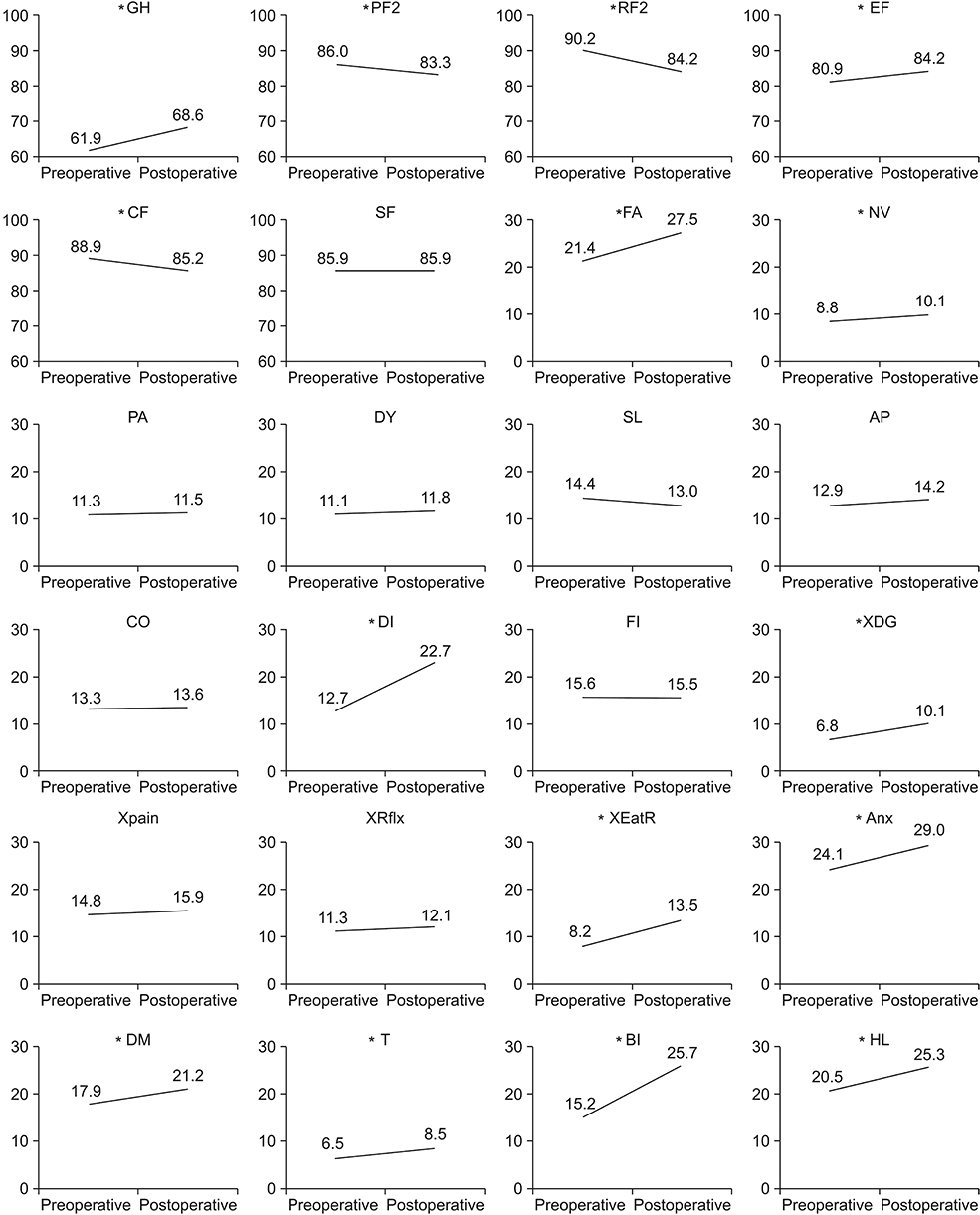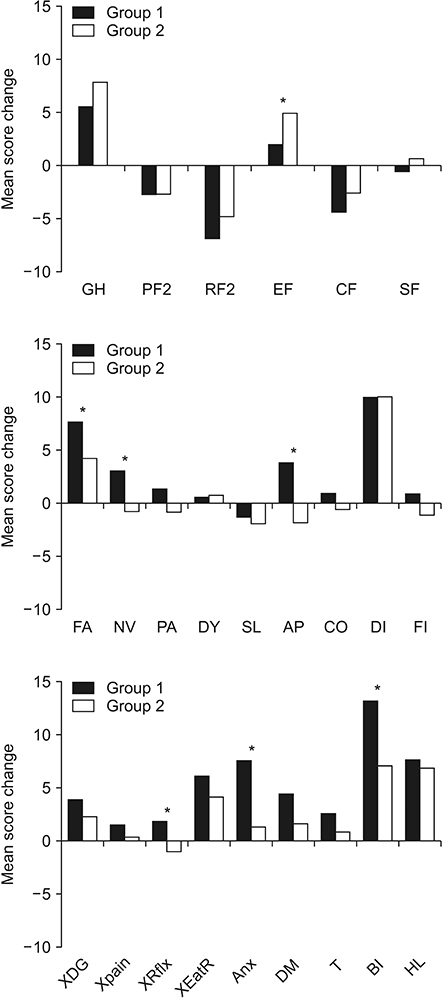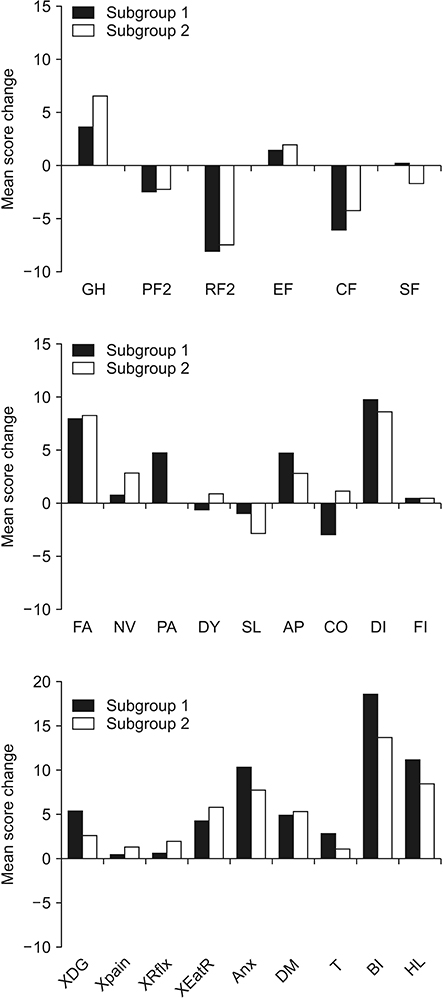Ann Surg Treat Res.
2019 May;96(5):250-258. 10.4174/astr.2019.96.5.250.
Impact of body mass index on quality of life after distal gastrectomy for gastric cancer
- Affiliations
-
- 1Gastric Cancer Center, Kyungpook National University Chilgok Hospital, Daegu, Korea. wyu@knu.ac.kr
- KMID: 2443588
- DOI: http://doi.org/10.4174/astr.2019.96.5.250
Abstract
- PURPOSE
Few studies have evaluated changes in quality of life (QoL) in relation to changes in body mass index (BMI) after gastrectomy. This study aimed to evaluate the impact of postoperative changes in BMI on QoL after distal gastrectomy in gastric cancer patients.
METHODS
QoL data from the European Organization for the Research and Treatment of Cancer (EORTC) gathered via the QLQ-C30 and QLQ-STO22 questionnaires were obtained from 1,036 patients preoperatively and at 1 year postoperatively. The patients were divided into 2 groups: group 1 - decreased postoperative BMI and group 2 - unchanged or increased postoperative BMI.
RESULTS
There were 577 patients in group 1 and 459 in group 2. According to global health status and functional scales, emotional functioning (P = 0.035) was significantly worse in group 1 than in group 2 at 1 year postoperatively. Furthermore, there were significant decreases in QoL symptom scale scores, including fatigue (P = 0.016), nausea and vomiting (P = 0.002), and appetite loss (P = 0.001) scores, in group 1 compared with group 2. Regarding QLQ-STO22, reflux symptoms (P = 0.020), anxiety (P = 0.003), and body image (P = 0.003) were significantly worse in group 1 than in group 2 at 1 year after surgery.
CONCLUSION
BMI changes after distal gastrectomy influence QoL. Focus on controlling gastrointestinal symptoms and providing psychological support is essential in patients with decreased BMI after surgery. Patients should be offered follow-up care to assist them in maintaining BMI, for example, through dietary-behavior modifications and via intensive nutritional support, to prevent QoL deterioration after distal gastrectomy.
MeSH Terms
Figure
Cited by 2 articles
-
Chronological changes in quality of life and body composition after gastrectomy for locally advanced gastric cancer
Ki Bum Park, Ji Yeon Park, Seung Soo Lee, Ho Young Chung, Oh Kyoung Kwon
Ann Surg Treat Res. 2020;98(5):262-269. doi: 10.4174/astr.2020.98.5.262.Postoperative quality of life after gastrectomy in gastric cancer patients: a prospective longitudinal observation study
Chao-Jie Wang, Yun-Suhk Suh, Hyuk-Joon Lee, Ji-Hyeon Park, Shin-Hoo Park, Jong-Ho Choi, Fadhel Alzahrani, Khalid Alzahrani, Seong-Ho Kong, Do-Joong Park, Hui Cao, Han-Kwang Yang
Ann Surg Treat Res. 2022;103(1):19-31. doi: 10.4174/astr.2022.103.1.19.
Reference
-
1. McCall MD, Graham PJ, Bathe OF. Quality of life: a critical outcome for all surgical treatments of gastric cancer. World J Gastroenterol. 2016; 22:1101–1113.
Article2. Yu W, Park KB, Chung HY, Kwon OK, Lee SS. Chronological changes of quality of life in long-term survivors after gastrectomy for gastric cancer. Cancer Res Treat. 2016; 48:1030–1036.
Article3. Park KB, Lee SS, Kwon OK, Chung HY, Yu W. Chronological changes in quality of life after distal gastrectomy for gastric cancer. J Gastric Cancer. 2017; 17:110–119.
Article4. Davis JL, Selby LV, Chou JF, Schattner M, Ilson DH, Capanu M, et al. Patterns and predictors of weight loss after gastrectomy for cancer. Ann Surg Oncol. 2016; 23:1639–1645.
Article5. Heneghan HM, Zaborowski A, Fanning M, McHugh A, Doyle S, Moore J, et al. Prospective study of malabsorption and malnutrition after esophageal and gastric cancer surgery. Ann Surg. 2015; 262:803–807.
Article6. Bottomley A. The cancer patient and quality of life. Oncologist. 2002; 7:120–125.
Article7. Aaronson NK, Ahmedzai S, Bergman B, Bullinger M, Cull A, Duez NJ, et al. The European Organization for Research and Treatment of Cancer QLQ-C30: a quality-of-life instrument for use in international clinical trials in oncology. J Natl Cancer Inst. 1993; 85:365–376.
Article8. Vickery CW, Blazeby JM, Conroy T, Arraras J, Sezer O, Koller M, et al. Development of an EORTC disease-specific quality of life module for use in patients with gastric cancer. Eur J Cancer. 2001; 37:966–971.
Article9. Kim AR, Cho J, Hsu YJ, Choi MG, Noh JH, Sohn TS, et al. Changes of quality of life in gastric cancer patients after curative resection: a longitudinal cohort study in Korea. Ann Surg. 2012; 256:1008–1013.10. Karanicolas PJ, Graham D, Gonen M, Strong VE, Brennan MF, Coit DG. Quality of life after gastrectomy for adenocarcinoma: a prospective cohort study. Ann Surg. 2013; 257:1039–1046.11. Nishigori T, Okabe H, Tsunoda S, Shinohara H, Obama K, Hosogi H, et al. Superiority of laparoscopic proximal gastrectomy with hand-sewn esophagogastrostomy over total gastrectomy in improving postoperative body weight loss and quality of life. Surg Endosc. 2017; 31:3664–3672.
Article12. Lee SS, Chung HY, Kwon OK, Yu W. Long-term quality of life after distal subtotal and total gastrectomy: symptom- and behavior-oriented consequences. Ann Surg. 2016; 263:738–744.13. Park KB, Park JY, Lee SS, Kwon OK, Chung HY, Yu W. Impact of body mass index on the quality of life after total gastrectomy for gastric cancer. Cancer Res Treat. 2018; 50:852–860.
Article14. WHO Expert Consultation. Appropriate body-mass index for Asian populations and its implications for policy and intervention strategies. Lancet. 2004; 363:157–163.15. Fujiwara M, Kodera Y, Kasai Y, Kanyama Y, Hibi K, Ito K, et al. Laparoscopy-assisted distal gastrectomy with systemic lymph node dissection for early gastric carcinoma: a review of 43 cases. J Am Coll Surg. 2003; 196:75–81.
Article16. Kanaya S, Gomi T, Momoi H, Tamaki N, Isobe H, Katayama T, et al. Delta-shaped anastomosis in totally laparoscopic Billroth I gastrectomy: new technique of intraabdominal gastroduodenostomy. J Am Coll Surg. 2002; 195:284–287.17. Yun YH, Park YS, Lee ES, Bang SM, Heo DS, Park SY, et al. Validation of the Korean version of the EORTC QLQ-C30. Qual Life Res. 2004; 13:863–868.
Article18. Fayers PM. Interpreting quality of life data: population-based reference data for the EORTC QLQ-C30. Eur J Cancer. 2001; 37:1331–1334.19. Kim YW, Baik YH, Yun YH, Nam BH, Kim DH, Choi IJ, et al. Improved quality of life outcomes after laparoscopy-assisted distal gastrectomy for early gastric cancer: results of a prospective randomized clinical trial. Ann Surg. 2008; 248:721–727.20. Kiyama T, Mizutani T, Okuda T, Fujita I, Tokunaga A, Tajiri T, et al. Postoperative changes in body composition after gastrectomy. J Gastrointest Surg. 2005; 9:313–319.
Article21. Park S, Chung HY, Lee SS, Kwon O, Yu W. Serial comparisons of quality of life after distal subtotal or total gastrectomy: what are the rational approaches for quality of life management. J Gastric Cancer. 2014; 14:32–38.
Article22. Kobayashi D, Kodera Y, Fujiwara M, Koike M, Nakayama G, Nakao A. Assessment of quality of life after gastrectomy using EORTC QLQ-C30 and STO22. World J Surg. 2011; 35:357–364.
Article23. Tanabe K, Takahashi M, Urushihara T, Nakamura Y, Yamada M, Lee SW, et al. Predictive factors for body weight loss and its impact on quality of life following gastrectomy. World J Gastroenterol. 2017; 23:4823–4830.
Article
- Full Text Links
- Actions
-
Cited
- CITED
-
- Close
- Share
- Similar articles
-
- Prevalence, Pathophysiology, Screening and Management of Osteoporosis in Gastric Cancer Patients
- Impact of Body Mass Index on the Quality of Life after Total Gastrectomy for Gastric Cancer
- Quality of Life after Curative Surgery in Patients with Gastric Cancer: Comparison between a Subtotal Gastrectomy and a Total Gastrectomy
- Quality of Life and Nutritional Outcomes of Billroth I and Billroth II Reconstruction
- The Impact of Obesity on the Use of a Totally Laparoscopic Distal Gastrectomy in Patients with Gastric Cancer






